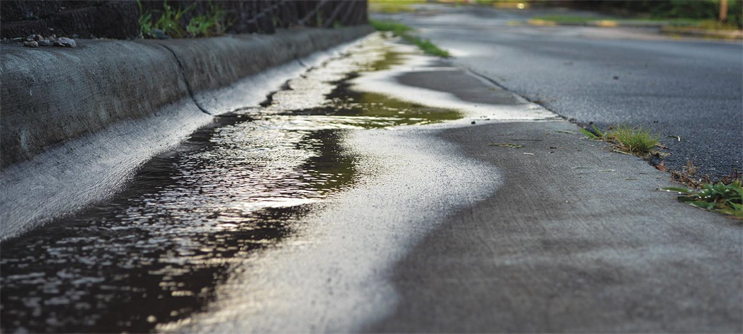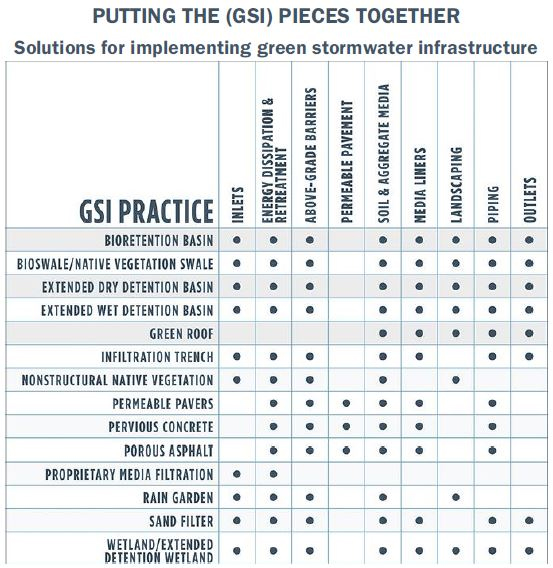Reversing The Process: Urban Planners Should Focus On Water First
By Brenda Macke
With concerns over stormwater management escalating, green stormwater infrastructure (GSI) offers a multi-benefit, cost-effective solution.
Is it time to consider that we may have been doing urban planning backward?
Community planning professionals have typically focused first on the features of the urban environment they wish to design before considering stormwater control infrastructure. However, this approach can overlook one important fact: No one can out-design Mother Nature.
Even the most well-designed stormwater management system is no match for the power and destructive force of water that exceeds normal rainfall volumes. Stormwater will inevitably follow the pull of gravity to find the downhill path of least resistance. And that can lead to sewer overflows, flooding, and stream degradation, among other things.
As we look to the future, we must rethink our approach to stormwater management. We must put water first.
Think about how different our urban areas might look if, instead of developing them using a traditional street grid system, we began by allowing stormwater runoff to follow natural pathways. These aboveground streams and drainage areas would be incorporated into our urban landscape with planners designing streets, structures, and community green spaces around them.
Changing The Urban Landscape
Many of the water quality and runoff issues cities face today are the result of the impervious surfaces created through urban development. As development grows more dense, higher volumes of stormwater flows are directed into legacy pipes and other elements of a conveyance system that have traditionally been built below ground.
However, putting more or larger pipes in the ground to move stormwater downstream as quickly as possible is rarely the smartest or most cost-effective answer. Urban environments in the future can realize multiple benefits by relying on stormwater best-management practices — also called green stormwater infrastructure (GSI) — to reduce impervious surfaces, capture water in multiple retention zones, and direct flows toward natural places.
GSI can be comprised of a range of systems, landscaped features, and technologies that collect, store, and slow the velocity of water, while also creating multiple aesthetic and economic benefits for communities. While these systems supplement conventional stormwater inlets and pipes, the main benefit is that they do not represent a one-size-fits-all approach. Each GSI plan is customized for specific locations and conditions, often incorporating plants and natural materials native to the areas where they are installed. Examples can include tree planters along urban streets, pervious pavers or pavement, green roofs, or even wetlands with detention for larger applications.
Urban planning should therefore include open spaces and drainage areas where rainwater can collect and drain naturally. These environments will also benefit from multipurpose spaces that serve, for example, as a trail system one day and a detention basin for stormwater the next.

"Part of our job as planners is to educate and, in some cases, reeducate those who have long believed it’s our job to eliminate standing water."
This is a concept that runs counter to the expectations of most city dwellers, who normally associate standing water with flooding. Part of our job as planners is to educate and, in some cases, reeducate those who have long believed it’s our job to eliminate standing water. In the urban environment of the future, we all will have to become comfortable with seeing such water ebb and flow as part of the natural ecosystem.
Because each watershed has its own unique characteristics, design solutions often must incorporate both “green” and “gray” infrastructure. This means combined sewers or storm sewers will continue to play important roles in urban infrastructure, and many will need to be rehabilitated or replaced as they age. But where it makes sense to reestablish natural drainage channels, planners should consider doing so.

Even in highly developed urbanized areas, we should seek sustainable, green infrastructure solutions whenever practical. If there are areas that continue to experience flooding, preservation of this area to do just that rather than redeveloping may make the most sense.
Residents can be expected to take an increasingly important role in understanding the causes of runoff and controlling their contributions to it.
As an example, our firm recently worked with a Midwest community after severe, repeated flooding had impacted certain parts of the community. A mapping-based tool we developed now allows the city engineer to map the community’s natural drainage paths. Residents who report repeated flooding can now overlay a map of their property with that of the natural drainage paths. By considering how water runs through and drains from a given land area, it’s possible to evaluate all the sources that affect water quality and quantity. In other words, communities are taking a watershed management approach to managing their water resources. Urban planners would be wise to follow their lead.
About The Author
 Brenda Macke, PE, is a project manager in the Water Group at Burns & McDonnell. She is an integral team member for the Kansas City, MO, Smart Sewer green team, as well as the green stormwater infrastructure (GSI) task leader serving the Unified Government of Wyandotte County and Kansas City, KS. Her passions include planning and designing sustainable stormwater infrastructure, and she has previously worked with a variety of regional and national projects focused on helping communities meet NPDES Phase II regulations, FEMA requirements, and EPA consent orders.
Brenda Macke, PE, is a project manager in the Water Group at Burns & McDonnell. She is an integral team member for the Kansas City, MO, Smart Sewer green team, as well as the green stormwater infrastructure (GSI) task leader serving the Unified Government of Wyandotte County and Kansas City, KS. Her passions include planning and designing sustainable stormwater infrastructure, and she has previously worked with a variety of regional and national projects focused on helping communities meet NPDES Phase II regulations, FEMA requirements, and EPA consent orders.
